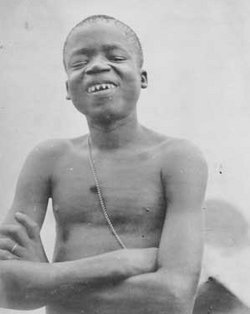Zulu_warrior Member Username: Zulu_warrior Post Number: 2553 Registered: 10-2003 Posted From: 68.251.27.41 |
http://www.rae.org/otabenga.html Ota Benga (c. 1881–1916) was a Congolese pygmy who was featured in an exhibit at the Bronx Zoo as "The Missing Link" along with an orangutan.  Ota Benga Biography American missionary Samuel Phillips Verner met Ota Benga in 1904, in what was then the Belgian Congo. His village had been wiped out by a group of mercenaries working for the Belgian government and he had been sold into slavery. Verner had been sent to Africa under contract from the St. Louis World's Fair to bring back pygmies for exhibition. He negotiated with the tribal slave trader and returned to the U.S. with Ota Benga and eight others. After the fair, Verner brought the 18-year-old Ota Benga and the others back to the Congo, but Ota Benga's time in the white world had tainted him among the scattered remnants of his tribe. After his second wife died from a snake bite, he agreed to return to America with his benefactor. After several months of travel in the U.S., Verner took Ota Benga to the Bronx Zoo in 1906 in hopes of finding him a place to live. And at first, the young man was allowed to roam the grounds and help feed the animals. Socialite and amateur anthropologist Madison Grant, head of the New York Zoological Society, had Ota Benga put on display at the Bronx Zoo in New York City alongside the apes and other animals. Zoo director W.H. Hornaday decided to use Ota Benga as a public attraction. At the behest of Grant, a prominent scientific racist and eugenicist, Hornaday placed Ota Benga in a cage with an orangutan and labeled him "The Missing Link" in an attempt to illustrate human evolution, and in particular that Africans like Ota Benga were closer to apes than were Europeans. Eventually, protest from African-American clergymen had Ota Benga removed from exhibit—but not on the grounds that the exhibit was racist, but that it too strongly promoted Darwinian evolution. Hornaday caved in under the pressure and released Ota Benga to Gordon, who placed him in the Howard Colored Children's Orphan Asylum sponsored by his church. When that didn't work out, Moses — a graduate of Virginia Seminary in Lynchburg — arranged with then Seminary president Gregory Hayes to bring Ota Benga to Lynchburg. While in Virginia, Ota Benga's teeth, which had been filed to points, were capped, and he was dressed in American-style clothes. He was tutored by Lynchburg poet Anne Spencer and briefly attended classes at the Seminary. He was much more at home discarding his clothes and roaming the nearby woods with his bow and arrow. He discontinued his formal education and began working at one of the Lynchburg tobacco factories. Despite his small size (he was measured at one point at 4-foot-11, 103 pounds) he proved a valuable employee because he could climb up the poles to get the tobacco leaves without having to use a ladder. Ota Benga was caught between two worlds, unable to return to Africa and viewed mainly as a curiosity in the U.S. One day in March of 1916, he built a ceremonial fire, performed a final tribal dance, and shot himself with a stolen pistol. The death certificate listed his name as "Otto Bingo." He was buried, records show, in the black section of the Old City Cemetery, near his benefactor, Gregory Hayes. At some point, however, both turned up missing. Local oral history indicates that Hayes and Ota Benga were eventually moved from the Old Cemetery to White Rock Cemetery, a burial ground that fell into disrepair. http://en.wikipedia.org/wiki/Ota_Benga |